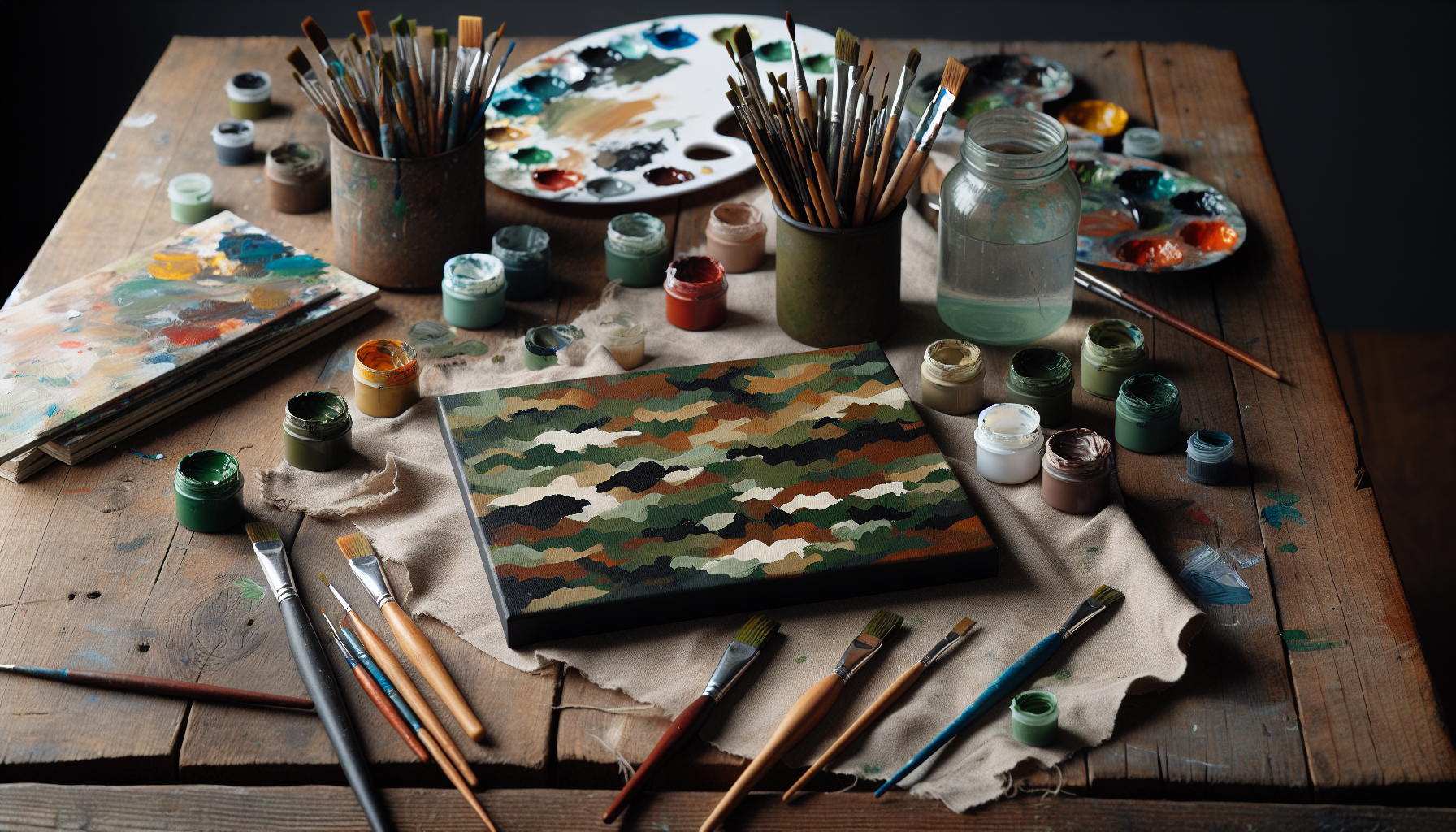Are you looking to add a touch of artistry to your acrylic paintings? If you find yourself struggling with capturing the intricate details of hands, fear not! In this article, we will explore the step-by-step process of painting hands with acrylics. From understanding the underlying structure to creating realistic skin tones and textures, you’ll gain valuable insights on how to bring hands to life on canvas. So grab your brushes and let’s embark on a journey to master the art of painting hands with acrylic.
Materials needed
To paint hands with acrylic, you will need the following materials:
Acrylic paints
Acrylic paints are versatile and vibrant, making them a great choice for painting hands. They come in a wide range of colors, allowing you to create realistic skin tones and add depth to your artwork.
Paintbrushes
Having a variety of paintbrushes is essential for painting hands. Choose brushes of different sizes and shapes to accommodate various areas and details of the hand.
Palette
A palette is necessary for mixing and holding your acrylic paints. You can use a traditional palette made of plastic or wood, or even a disposable palette pad for convenience.
Canvas or paper
Choose a canvas or paper surface on which to paint your hands. Canvases are durable and versatile, while paper provides an affordable option for practice and experimentation.
Water cup
A water cup is necessary for rinsing your brushes and keeping them clean throughout the painting process. It’s important to keep your brushes moist to prevent the paint from drying out.
Paper towel
Having a paper towel on hand is useful for drying your brushes, blotting excess paint, and cleaning up any accidental spills or smudges.
Preparing the workspace
Before you start painting hands with acrylic, it’s essential to prepare your workspace. Here are some steps to follow:
Clear the work area
Start by clearing your work area of any unnecessary clutter or distractions. Having a clean and organized space will help you focus on your painting and prevent any accidents or mishaps.
Cover the surface
To protect your work surface from paint spills or stains, it’s a good idea to cover it with a plastic or disposable tablecloth, old newspapers, or a drop cloth. This will make clean-up easier and ensure that your work area stays tidy.
Organize the materials
Arrange your acrylic paints, paintbrushes, palette, water cup, and paper towel in an orderly manner. This will make it easier for you to access your materials as you paint, allowing for a smoother and more efficient painting process.

Understanding the hand structure
Before you begin painting hands, it’s helpful to have an understanding of the hand’s structure. This will enable you to accurately depict the hand’s shape, proportions, and details. Here are some key aspects to consider:
Recognizing the basic shapes
The hand can be broken down into basic geometric shapes such as cylinders, spheres, and cubes. By identifying these shapes within the hand, you can better understand its three-dimensional structure and how to represent it in your painting.
Identifying proportions
Understanding the proportions of the hand is essential for creating a realistic depiction. Pay attention to the length and width of each finger, the relative size of the palm, and the placement of joints and knuckles.
Observing shadows and highlights
Shadows and highlights play a crucial role in adding depth and dimension to your painting. Observe how light interacts with the hand, creating areas of shadow and areas that catch the light. This will help you understand how to represent these variations in tone in your artwork.
Creating a color palette
To paint hands realistically, it’s important to create a color palette that accurately represents skin tones and captures the nuances of light and shadow. Here are some steps to create a well-balanced color palette:
Choosing skin tones
Start by selecting a range of colors that closely match the skin tones you want to depict. Consider factors such as ethnicity, age, and lighting conditions when choosing these colors.
Mixing primary colors
Begin by mixing your primary colors on your palette. Acrylic paint allows for easy color mixing, so experiment with different combinations of red, yellow, and blue to create a variety of skin tones.
Adding variations
To make your color palette more dynamic, add variations to your skin tones. Mix in small amounts of complementary colors or add a touch of white or black to create different shades and tones. This will help add depth and realism to your painting.

Sketching the hand
Before diving into the painting process, it’s helpful to sketch the hand on your canvas or paper. This will provide you with a basic outline to work with and help you establish the correct proportions. Here’s how to sketch the hand:
Using a pencil
Start by using a pencil to lightly sketch the general outline of the hand. Pay close attention to the placement of the fingers, the overall shape of the palm, and any particular details you want to include.
Drawing basic shapes
Using the principles of hand structure you learned earlier, draw basic shapes to represent the various parts of the hand. These shapes will serve as a guide for your painting and help you establish correct proportions.
Refining the outline
Once you have the basic shapes in place, refine the outline of the hand by adding more detail and smoothing out any rough edges. Take your time during this stage to ensure that the hand looks realistic and accurately represents your intended pose or gesture.
Blocking in the base colors
With the sketch completed, it’s time to start applying paint to the canvas. Begin by blocking in the base colors, which will establish the overall color and value of the hand. Here’s how to do it:
Using large brushes
Start by using larger brushes to apply broad strokes of paint to cover the basic shapes of the hand. This will give you a solid foundation to work from and provide a base on which to build.
Applying thin layers
To achieve a smooth and even application of paint, apply thin layers of color. This will allow you to gradually build up the intensity and value as you work.
Building up volume
As you block in the base colors, consider the three-dimensional structure of the hand and how the light falls on its various surfaces. Use darker shades to create areas of shadow and lighter shades to represent areas that catch the light. This will help give your painting depth and realism.

Adding shadows and highlights
Once the base colors are in place, it’s time to add shadows and highlights to your painting. This step will bring depth and dimension to your artwork. Here’s what to do:
Identifying light source
Determine the direction of the light source in your painting. This will dictate where shadows and highlights should be placed. Consistency with the light source throughout your painting will create a convincing illusion of depth and realism.
Mixing darker shades
Mix darker shades of your base colors to represent shadows. Observe the areas of the hand that are in shadow and apply these darker shades strategically to create a sense of depth and form.
Layering for depth
To achieve realistic shadows and highlights, layer thin glazes of paint on top of your base colors. Gradually build up the intensity and value of these areas, paying attention to the subtle variations in tone and texture that occur on the hand’s surface.
Rendering the details
With the basic colors and values established, it’s time to focus on rendering the details of the hand. This step will bring your painting to life and add a sense of realism. Here’s how to do it:
Using smaller brushes
Switch to smaller brushes to capture the smaller details of the hand. Use these brushes to carefully paint the lines and wrinkles, the textures on the skin, and any other specific details you want to include.
Capturing wrinkles and lines
Observe the hand’s wrinkles, creases, and lines and replicate these details in your painting. Pay attention to the direction and depth of these lines. This attention to detail will make your painting more lifelike and realistic.
Adding texture
To give your painting a sense of texture, consider using various techniques to mimic the texture of the hand’s skin. You can use dry brushing to create a rougher texture or glazes to achieve a smoother, more polished appearance. Experiment with different techniques to find what works best for your desired effect.

Blending and smoothing
To create a seamless transition between colors and to soften harsh edges, it’s important to blend and smooth your paint. This will give your painting a polished and professional look. Here’s how to do it:
Utilizing wet-on-wet technique
By applying wet paint onto wet paint, you can achieve smooth transitions and blending. This technique allows the colors to mix and meld together, creating a soft and harmonious appearance.
Softening transitions
Use a clean brush or a small amount of water to gently blend the edges between different colors. This will help create a gradual transition between shades and create a more realistic representation of the hand’s surfaces.
Creating seamless transitions
Take your time during this phase to ensure that your transitions appear natural and seamless. Use a light touch and blend the colors gradually to avoid creating any harsh lines or visible brush strokes.
Final touches and refinements
As you near the completion of your painting, it’s time to add the final touches and refinements. These finishing touches will enhance the realism and overall impact of your artwork. Here’s what to do:
Adjusting colors and tones
Step back and assess your painting as a whole. Look for any areas where colors or tones need adjusting. Make any necessary tweaks to ensure that your painting accurately represents the subject and achieves the desired effect.
Adding final highlights
Use lighter shades of your base colors or even pure white to add final highlights. These highlights should be placed where the light source hits the hand most directly. This will bring a luminosity and sense of realism to your painting.
Enhancing realism
Take a critical look at your painting and make any additional refinements to enhance the realism. This could involve adjusting the details, adding more texture, or refining the overall composition. Trust your instincts and make any changes that you feel will bring your painting to its full potential.
By following these step-by-step instructions, you’ll be able to paint hands with acrylic confidently. Remember to practice regularly, experiment with different techniques, and embrace the joy of creative expression as you embark on your painting journey. Happy painting!




